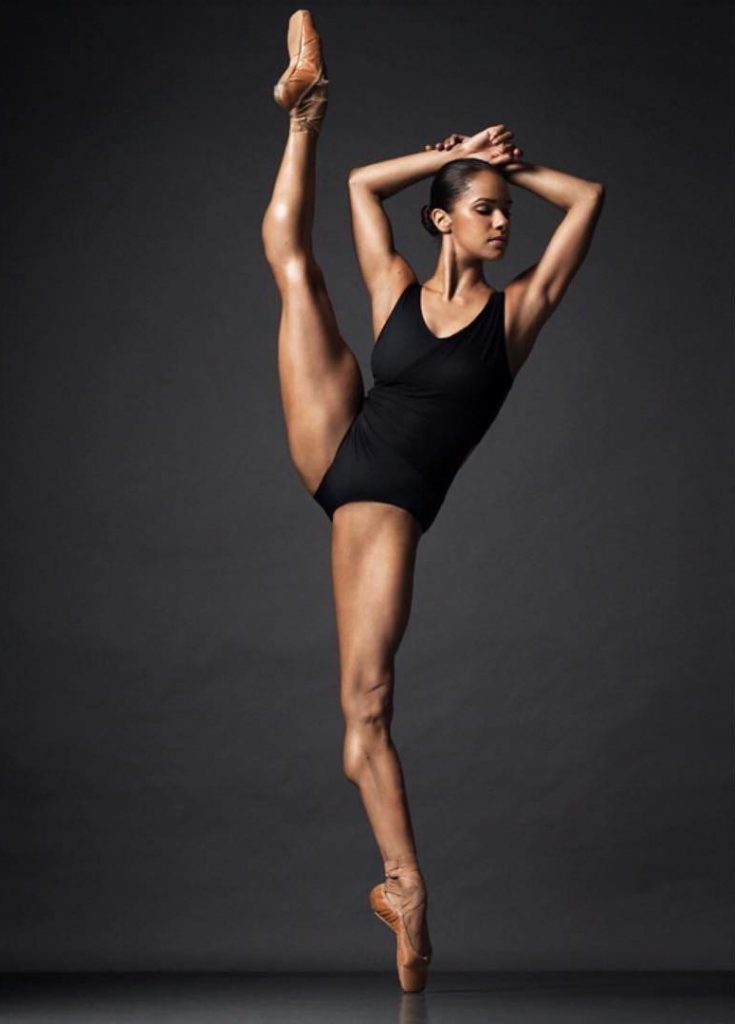“Et un et deux et trois” (and one, and two, and three), are the countless hymns that a typical ballet dancer hears from the rise of dawn to long after sunset. Their long hours in the studio, being constantly on their feet (known as releve), becomes their everyday regime, including exaggerated arm extensions and feet so numb that they do not even feel the blisters from their point shoes; these are examples of the sacrifices and commitments that young ballet dancers experience to make the top one percent that become professionals. An aspiring young African-American woman named Misty Copeland was born to break all barriers in the dance world and change the image of what a ballerina should look like. Misty grew up in a household of five siblings, to a mother of multiple marriages, and to a father who was nearly absent from her life for twenty years; she became American Ballet Theater’s first African-American ballet dancer.1 She is world renowned for her acclaimed performances and the statuesque perfection that has made her an elite dancer. Growing up, she never realized her potential, because of her constant fight for her mother’s attention among her other siblings. Copeland soon realized her passion for dance when she performed dance routines at home to a Mariah Carey chart topper. With no formal ballet or gymnastics experience, she tried out for her middle school drill team, following in her older sister’s footsteps; the elite dance team was recognized for winning countless statewide competitions.2

Even though Misty’s frame was regarded as petite, at thirteen years old Misty was able to use her assertiveness that she gained at home to become captain of the drill team. She was praised for her natural grace and finesse on the dance floor, which later came to the attention of her classically trained coach, Elizabeth Cantine. Off the dance floor, Copeland struggled with the difficulties that her family was enduring. In the year 1994, after her mother’s various friends and boyfriends, her family moved into a small two bedroom Inn in Gardena, California. Along with her brothers and sisters, Misty slept on the floor with only blankets. She regards this memory as, “The hardest time in my childhood,” saying that she made up for the chaos at home by working doubly hard at school.3
Misty’s dance career began at a later age than that of most elite dancers; the average dancer begins training between the ages of four and eight, but her formal training did not begin until age thirteen. Copeland’s middle school drill team coach encouraged her to attend the Boys and Girls Club, where a ballet instructor, Cynthia Bradley, taught free ballet classes once a week. Misty originally declined the offer because her mother did not have a car, and was working twelve to fourteen hours a day, and her oldest sister Erica was working two jobs. But Instructor Bradley began picking Misty up from school. Copeland was able to demonstrate how others’ preconceptions can be disproved with raw talent, “You can start late, look different, be uncertain, and still succeed.”4 Within her brief three months of training with Bradley, Copeland had mastered the French technique of en pointe, which signifies standing on the tip of your toes in ballet shoes, something that takes most ballerinas years to master. As her training became more intensive, Misty began spending most of her hours at the studio, which angered her mother, who told her that she would have to give up ballet. However, Bradley saw a spark of passion in Misty, and offered to host her during her training, as many trainers do for professional athletes. Her mother concluded that it was the best option, considering that their home life was unstable. Copeland explained that the feel of slippers and leotards gave her a sense of confidence and empowerment; she felt like she finally fit in. She had a place to call home and a sport to idolize: “Ballet was so structured. I’d been craving something that could guide me.”5 In the year 1998, at the age of fifteen, she won first prize in the ballet category of the Los Angeles Music Center Spotlight Awards.6

However, that same year a custody battle ensued between the Bradleys and Copeland’s mother. Misty had to return home to her mother, and they had frequent arguments. Her mother had long resented the Bradleys’ influence of homeschooling, Christian religion, and far more personal attention with Misty, and ultimately she decided that Misty would have to cease her continuation with the Bradleys. Misty was distraught with the fear that she would not be able to continue her dance career. The Bradleys then helped Misty to emancipate herself, which was a procedure common among young performers for securing their financial and residential independence. After Misty’s mother received the emancipation documents, she hired famous feminist attorney Gloria Allred and applied a series of restraining orders, which included the Bradleys’ five-year-old son. The order was partly intended to preclude contact between the Bradleys and Misty, but it did not have proper legal basis, since there had been no stalking or harassment.7 The custody controversy was highly publicized in the press: “The attention was devastating,” she says. “I had been so private. It was scarring.”8 After Misty’s mother stated that she would make sure Copeland could dance, both emancipation papers and restraining orders were dropped.
Copeland then began attending San Pedro High School, and continued to study at Lauridsen Ballet Centre in Torrance, California. In 2000, Copeland won another full scholarship, this time to American Ballet Theater’s intensive summer program; and soon after, she became the only African-American woman in a group of eighty dancers. Though she was challenged by her difference, not only her skin color but also her body type, always more full figured than her peers, she nevertheless climbed the ranks by virtue of her exceptional skill.9 In 2007, she became the company’s first African-American female soloist in two decades, with notable performances in The Firebird (2012), in Le Corsaire (2013), and in Swan Lake (2014), to name a few. Copeland’s inspiring story made her a role model and pop icon. She is a New York Times Bestseller in Ballerina Body, a memoir Life in Motion, and Firebird, an inspiring children’s book that shows that through hard work and dedication any young dancer can become a Firebird.10 “I had moments of doubting myself, and wanting to quit, because I didn’t know that there would be a future for an African-American woman to make it to this level. At the same time, it made me so hungry to push through to carry the next generation. So it’s not me up here and I’m constantly saying that it’s everyone that came before me that got me to this position.”11
- Encyclopedia Britannica, 2016, s.v. “Internet,” by Naomi Blumburg. https://www.britannica.com/biography/Misty-Copeland (accessed February 18, 2018). ↵
- Kristen Mascia, “Misty Copeland on Love, Life, and Leaps of Faith,” Elle Magazine, May 29, 2014, 1. ↵
- Kristen Mascia, “Misty Copeland on Love, Life, and Leaps of Faith,” Elle Magazine, May 29, 2014, 1. ↵
- Misty Copeland, Life in Motion (New York: Scholastic Inc, 2017), 262. ↵
- Kristen Mascia, “Misty Copeland on Love, Life, and Leaps of Faith,” Elle Magazine, May 29, 2014, 1. ↵
- Encyclopedia Britannica, 2016, s.v. “Internet,” by Naomi Blumburg. https://www.britannica.com/biography/Misty-Copeland (accessed February 18, 2018). ↵
- Misty Copeland, Life in Motion (New York: Scholastic Inc, 2017), 263. ↵
- Kristen Mascia, “Misty Copeland on Love, Life, and Leaps of Faith,” Elle Magazine, May 29, 2014, 1. ↵
- Encyclopedia Britannica, 2016, s.v. “Internet,” by Naomi Blumburg. https://www.britannica.com/biography/Misty-Copeland (accessed February 18, 2018). ↵
- Macey Morales, “Acclaimed Author, Ballerina Misty Copeland to serve as 2018 National Library Week Honorary Chair,” American Library Association. December 5, 2017, http://www.ala.org/news/press-releases/2017/12/acclaimed-author-ballerina-misty-copeland-serve-2018-national-library-week. (accessed February 18, 2018). ↵
- The Biography.com website, Misty Copeland Biography, https://www.biography.com/people/misty-copeland (accessed February 18, 2018). ↵



87 comments
Alexandra Camarena
This article is so inspiring! When I was younger I was a ballerina and I truly loved it. While I didn’t stick with it, it did make an impact on my life. However, since I was young I had always heard of Misty Copeland but had never really looked into who she was. Reading how she overcame all of her battles between her family, race, and body type was truly inspiring. I thought the author wrote this article very well.
Patricia Arechiga
I sustain so much respect for Misty Copeland. Being a dancer is seen almost as a hobby, something for fun, which may be true, but what many neglect seeing is the story, power and meaning behind each step. Being a female of color itself holds a lot of ‘boundaries’ in the eyes of society, but Misty was able to mold a different image of herself, her community and overall society. Passion, time and strength can drive one down a path of growth and success, but only so many make it past the persistence stage.
Cameron Lopez
My sister was really into ballet when she was younger and she really enjoyed it for many years but her motivation and passion was no where near what Misty Copeland had. I really liked this article because of the hope and nonstop drive she had to keep going. From starting with a harsh childhood and then finding herself and her dream.
Sharriah Martinez
When I was younger I had always wanted to be a ballerina , my mom put me in dancing but I had developed terrible stage fright. I wish i had the passion that Misty Copeland had. Her harsh childhood helped her develop grow stronger and find herself. In the article I liked the use of ballet terms, i truly learned alot. I am glad that Misty Copeland did not let the stereotypes of ballet get to her, she did not let her race or age define her and the talents she had.
Engelbert Madrid
Stories like Misty Copeland encourage young people to take any possible opportunity to reach for their goals. The purpose of this article is to share Misty Copeland’s story to inform people that it takes dedication and encouragement to help one person to achieve whatever seemed impossible. Similar to Copeland’s story, I’m inspired to take whatever chances there are in the music field to become a better musician.
Bianca-Rhae Jacquez
This article is inspiring. I have no prior knowledge about ballet before this article but I like how the author explained the terms that are important to this story. I loved that misty was able to overcome all of peoples idea of what a perfect ballerina was. She broke the mold of what a stereotypical dancers age and race had to be.
Alexandra Lopez
I was in ballet from the ages two to seventeen and I had never in those years had the passion and structure as Misty Copeland. This article was a beautiful read of hope and resilience by having a harsh childhood while finding herself. My favorite part of the article was the quote, “You can start late, look different, be uncertain, and still succeed.” The author did a great job of writing this piece. (reposted)
Esperanza Rojas
This was such an inspiring article to read, for several reasons. The author did a wonderful job in explaining the vocabulary of ballet to the readers and also made a point to show the sacrifices of a ballet dancer in the very beginning. Misty is an inspiration to others, even those outside her career profession. To read about someone that started out “late” and still succeed is relieving, because it breaks the stereotype of someone having to start from such a young age. It proves that talent can show up at any age.
Cynthia Rodriguez
I have always been fascinated by ballet. Although I am not a dancer, I enjoy watching ballerinas dance and the way they move so gracefully and elegantly. The fact that they are able to stand on the very tips of their feet is amazing to me. I’m sure it is very painful, yet they make it look easy. As the article mentioned, doing this takes years to master, but Misty Copeland was able to do it in just three months! That is so incredible. On top of that, she started at a much later age than most girls. I think that Copeland’s home life was difficult, but it is great that she did not let that mess with her determination and perseverance. Her hard work definitely paid off! I thought this article had sentences that flowed and nice images to go along with that. Very nice work!
Alexandra Lopez
I was in ballet from the ages two to seventeen and I had never in those years had the passion and structure as Misty Copeland. This article was a beautiful read of hope and resilience by having a harsh childhood while finding herself. My favorite part of the article was the quote, “You can start late, look different, be uncertain, and still succeed.” The author did a great job of writing this piece.